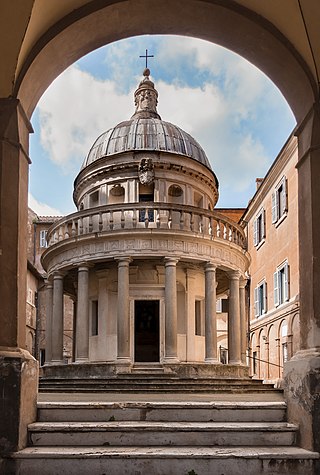
Renaissance architecture is the European architecture of the period between the early 15th and early 16th centuries in different regions, demonstrating a conscious revival and development of certain elements of ancient Greek and Roman thought and material culture. Stylistically, Renaissance architecture followed Gothic architecture and was succeeded by Baroque architecture and neoclassical architecture. Developed first in Florence, with Filippo Brunelleschi as one of its innovators, the Renaissance style quickly spread to other Italian cities. The style was carried to other parts of Europe at different dates and with varying degrees of impact.

Vincenzo Scamozzi was an Italian architect and a writer on architecture, active mainly in Vicenza and Republic of Venice area in the second half of the 16th century. He was perhaps the most important figure there between Andrea Palladio, whose unfinished projects he inherited at Palladio's death in 1580, and Baldassarre Longhena, Scamozzi's only pupil.

Andrea Palladio was an Italian Renaissance architect active in the Venetian Republic. Palladio, influenced by Roman and Greek architecture, primarily Vitruvius, is widely considered to be one of the most influential individuals in the history of architecture. While he designed churches and palaces, he was best known for country houses and villas. His teachings, summarized in the architectural treatise, The Four Books of Architecture, gained him wide recognition.

Sebastiano Serlio was an Italian Mannerist architect, who was part of the Italian team building the Palace of Fontainebleau. Serlio helped canonize the classical orders of architecture in his influential treatise variously known as I sette libri dell'architettura or Tutte l'opere d'architettura et prospetiva.
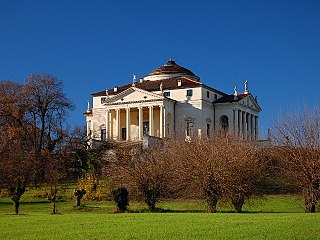
Villa La Rotonda is a Renaissance villa just outside Vicenza in Northern Italy designed by Italian Renaissance architect Andrea Palladio, and begun in 1567, though not completed until the 1590s. The villa's official name is Villa Almerico Capra Valmarana, but it is also known as "La Rotonda", "Villa Rotonda", "Villa Capra", and "Villa Almerico Capra". The name Capra derives from the Capra brothers, who completed the building after it was ceded to them in 1592. Along with other works by Palladio, the building is conserved as part of the World Heritage Site "City of Vicenza and the Palladian Villas of the Veneto".

GiacomoBarozzida Vignola, often simply called Vignola, was one of the great Italian architects of 16th century Mannerism. His two great masterpieces are the Villa Farnese at Caprarola and the Jesuits' Church of the Gesù in Rome. The three architects who spread the Italian Renaissance style throughout Western Europe are Vignola, Serlio and Palladio. He is often considered the most important architect in Rome in the Mannerist era.

The Tuscan order is one of the two classical orders developed by the Romans, the other being the composite order. It is influenced by the Doric order, but with un-fluted columns and a simpler entablature with no triglyphs or guttae. While relatively simple columns with round capitals had been part of the vernacular architecture of Italy and much of Europe since at least Etruscan architecture, the Romans did not consider this style to be a distinct architectural order. Its classification as a separate formal order is first mentioned in Isidore of Seville's 6th-century Etymologiae and refined during the Italian Renaissance.
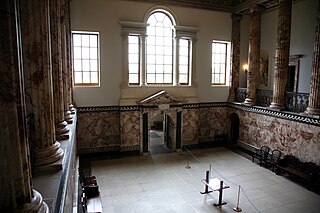
A Venetian window is a large tripartite window which is a key element in Palladian architecture. Although Sebastiano Serlio (1475–1554) did not invent it, the window features largely in the work of the Italian architect Andrea Palladio (1508–1580) and is almost a trademark of his early career. The true Palladian window is an elaborated version. Both the Venetian window or Serlian window and the Palladian window were inspired by Hellenistic and Roman examples which are part of the classical tradition and related to prestige and sacredness.

Sant'Andrea in Via Flaminia is a Roman Catholic church dedicated to St Andrew the Apostle in Rome, Italy. The edifice is also known as Sant'Andrea del Vignola, after its architect Giacomo Barozzi da Vignola.

Villa Chiericati is a villa at Vancimuglio in the Veneto, northern Italy. It was designed for Giovanni Chiericati by the architect Andrea Palladio in the early 1550s.

Villa Zeno is a patrician villa at Cessalto, Veneto, northern Italy, and is the most easterly villa designed by Italian Renaissance architect Andrea Palladio. The building is near the highway between Venice and Trieste, but was built to face a canal which served as the primary means of arrival.

The Villa Trissino is a patrician villa, which belonged to Gian Giorgio Trissino, located at Cricoli, just outside the center of Vicenza, in northern Italy. It was mainly built in the 16th century and is associated by tradition with the architect Andrea Palladio.

Villa Porto is a patrician villa in Vivaro di Dueville, province of Vicenza, northern Italy, designed in 1554 and traditionally attributed to the Italian Renaissance architect Andrea Palladio, but not included by UNESCO in the strict list of Palladian Villas of Veneto within the World Heritage Site City of Vicenza and the Palladian Villas of the Veneto.
In architecture, a parti is an organizing thought or decision behind an architect's design, presented in the form of a parti diagram, parti sketch, or a simple statement. The term comes from 15th century French, in which "parti pris" meant "decision taken."
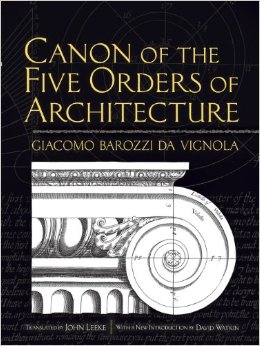
The Five Orders of Architecture is a book on classical architecture by Giacomo Barozzi da Vignola from 1562, and is considered "one of the most successful architectural textbooks ever written", despite having no text apart from the notes and the introduction. Originally published in Italian as Regola delli cinque ordini d'architettura, it has been fully or partially translated in English with different titles, including Canon of the Five Orders of Architecture; Rules of the Five Orders of Architecture; Vignola: an elementary treatise on architecture comprising the complete study of the five orders, with indication of their shadows and the first principles of construction; The Five Orders of Architecture according to Giacomo Barozzio of Vignola, to Which are Added the Greek Orders; and The five orders of architecture, the casting of shadows and the first principles of construction based on the system of Vignola.
The year 1554 CE in science and technology included a number of events, some of which are listed here.
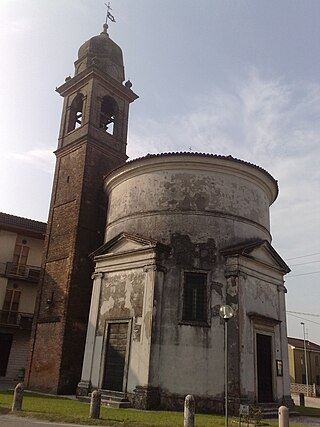
Count Alessandro Pompei (1705–1772) was an Italian architect and author of a prominent treatise on architecture: Cinque Ordini dell’ Architettura Civile di Michele Sanmicheli or Five Orders of the Civic Architecture of Michele Sanmicheli. Sanmicheli was a prominent venetian architect, who concentrated on solid and often staid government buildings.
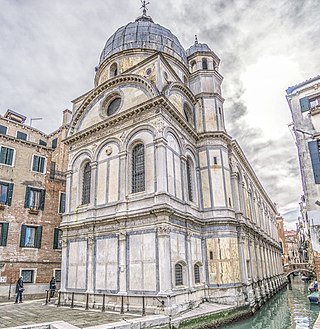
Venetian Renaissance architecture began rather later than in Florence, not really before the 1480s, and throughout the period mostly relied on architects imported from elsewhere in Italy. The city was very rich during the period, and prone to fires, so there was a large amount of building going on most of the time, and at least the facades of Venetian buildings were often particularly luxuriantly ornamented.

Italian Renaissance domes were designed during the Renaissance period of the fifteenth and sixteenth centuries in Italy. Beginning in Florence, the style spread to Rome and Venice and made the combination of dome, drum, and barrel vaults standard structural forms.


















